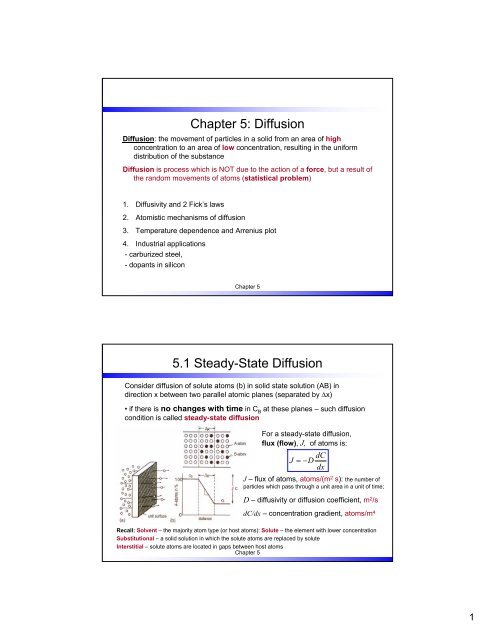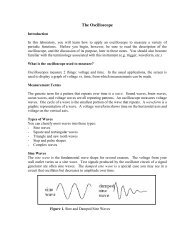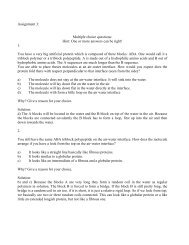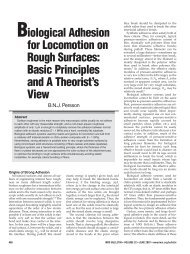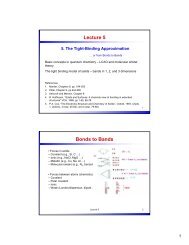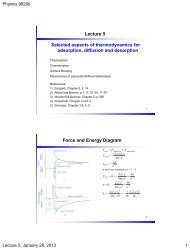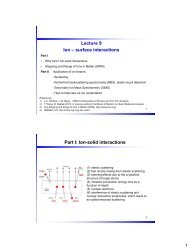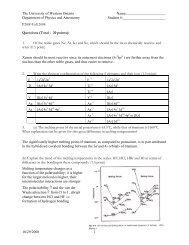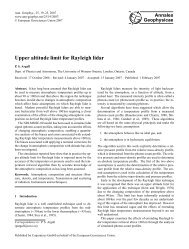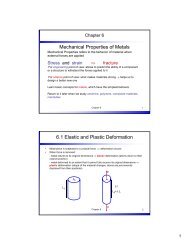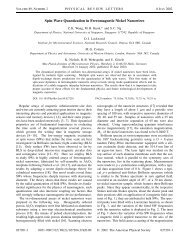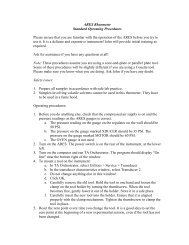Chapter 5: Diffusion 5.1 Steady-State Diffusion
Chapter 5: Diffusion 5.1 Steady-State Diffusion
Chapter 5: Diffusion 5.1 Steady-State Diffusion
Create successful ePaper yourself
Turn your PDF publications into a flip-book with our unique Google optimized e-Paper software.
<strong>Chapter</strong> 5: <strong>Diffusion</strong><br />
<strong>Diffusion</strong>: the movement of particles in a solid from an area of high<br />
concentration to an area of low concentration, resulting in the uniform<br />
distribution of the substance<br />
<strong>Diffusion</strong> is process which is NOT due to the action of a force, but a result of<br />
the random movements of atoms (statistical problem)<br />
1. Diffusivity and 2 Fick’s laws<br />
2. Atomistic mechanisms of diffusion<br />
3. Temperature dependence and Arrenius plot<br />
4. Industrial applications<br />
- carburized steel,<br />
- dopants in silicon<br />
<strong>Chapter</strong> 5<br />
<strong>5.1</strong> <strong>Steady</strong>-<strong>State</strong> <strong>Diffusion</strong><br />
Consider diffusion of solute atoms (b) in solid state solution (AB) in<br />
direction x between two parallel atomic planes (separated by ∆x)<br />
• if there is no changes with time in C B<br />
at these planes – such diffusion<br />
condition is called steady-state diffusion<br />
For a steady-state diffusion,<br />
flux (flow), J, of atoms is:<br />
dC<br />
J = −D<br />
dx<br />
J – flux of atoms, atoms/(m 2 s): the number of<br />
particles which pass through a unit area in a unit of time;<br />
D – diffusivity or diffusion coefficient, m 2 /s<br />
dC/dx – concentration gradient, atoms/m 4<br />
Recall: Solvent – the majority atom type (or host atoms): Solute – the element with lower concentration<br />
Substitutional – a solid solution in which the solute atoms are replaced by solute<br />
Interstitial – solute atoms are located in gaps between host atoms<br />
<strong>Chapter</strong> 5<br />
1
Fick’s first law of diffusion<br />
dC<br />
J = −D<br />
dx<br />
⎛ atoms ⎞ ⎛ m<br />
J⎜<br />
⎟ = −D<br />
⎜<br />
2<br />
⎝ m s ⎠ ⎝ s<br />
‘-’ sign: flux direction is from<br />
the higher to the lower<br />
concentration; i.e. it is the<br />
opposite to the concentration<br />
gradient<br />
2<br />
For steady-state diffusion condition (no change in the<br />
system with time), the net flow of atoms is equal to the<br />
diffusivity D times the diffusion gradient dC/dx<br />
⎞ dC ⎛ atoms 1 ⎞<br />
⎟ ⎜ ×<br />
3<br />
⎟<br />
⎠ dx ⎝ m m ⎠<br />
Diffusivity D depends on:<br />
1. <strong>Diffusion</strong> mechanism<br />
2. Temperature of diffusion<br />
3. Type of crystal structure (bcc > fcc)<br />
4. Crystal imperfections<br />
5. Concentration of diffusing species<br />
<strong>Chapter</strong> 5<br />
Non-<strong>Steady</strong>-<strong>State</strong> <strong>Diffusion</strong><br />
In practice the concentration of solute atoms at any point in<br />
the material changes with time – non-steady-state diffusion<br />
For non-steady-state condition, diffusion<br />
coefficient, D - NOT dependent on time:<br />
Second Fick’s law of diffusion:<br />
If D ≠ D(x), in 1D case:<br />
dC<br />
dt<br />
x<br />
=<br />
dC x<br />
dt<br />
d<br />
dx<br />
⎛ dC<br />
⎜ D<br />
⎝ dx<br />
2<br />
∂ C<br />
= D<br />
2<br />
∂x<br />
x<br />
⎞<br />
⎟<br />
⎠<br />
Change in concentration in 2 semi-infinite<br />
rods of Cu and Ni caused by diffusion, From<br />
G. Gottstein “Physical Foundations of<br />
Material Science”<br />
The rate of compositional change is equal to<br />
the diffusivity times the rate of the change of<br />
the concentration gradient<br />
In 3D case:<br />
dC x<br />
dt<br />
2 2 2<br />
⎛ ∂ C ∂ C ∂ C ⎞<br />
D<br />
⎜ + +<br />
⎟<br />
2 2<br />
⎝ ∂x<br />
∂y<br />
∂z<br />
⎠<br />
=<br />
2<br />
<strong>Chapter</strong> 5<br />
2
Non-<strong>Steady</strong>-<strong>State</strong> <strong>Diffusion</strong> (continued)<br />
With specific initial or boundary conditions this partial differential equations can be solved<br />
to give the concentration as function of spatial position and time c(x, y, z, t)<br />
Let us consider two rods with different concentrations c 1<br />
and c 2 which are joined at x=0 and both are so long that<br />
mathematically they can be considered as infinitely long<br />
The concentration profile at t = 0 is discontinuous at x = 0:<br />
x < 0, c = c 1 ; x < 0, c = c 2<br />
2<br />
dC<br />
We can obtain solution of: x<br />
∂ C<br />
= D<br />
2<br />
dt ∂x<br />
c<br />
c(<br />
x,<br />
t)<br />
− c =<br />
where erf ( z)<br />
=<br />
x<br />
z =<br />
2 Dt<br />
1<br />
2<br />
− c<br />
π<br />
2<br />
1<br />
2<br />
π<br />
z<br />
∫<br />
0<br />
x<br />
Dt<br />
∫<br />
−∞<br />
e<br />
e<br />
2<br />
−ξ<br />
2<br />
−ξ<br />
c<br />
dξ<br />
=<br />
2<br />
− c ⎛<br />
1 ⎛ x ⎞⎞<br />
1<br />
2<br />
⎜ + erf ⎜ ⎟<br />
2<br />
⎟<br />
⎝ ⎝ Dt ⎠⎠<br />
dξ,<br />
is known as the error function<br />
<strong>Chapter</strong> 5<br />
Gas diffusion into a solid<br />
Let us consider the case of a gas A diffusing into a solid B<br />
Gas A<br />
Solid B<br />
Cs<br />
− Cx<br />
C − C<br />
S<br />
o<br />
⎛<br />
= erf ⎜<br />
⎝ 2<br />
x<br />
Dt<br />
⎞<br />
⎟<br />
⎠<br />
x = 0<br />
C S – surf. C of element in gas diffusing into the<br />
surface<br />
C o – initial uniform concentration of element in<br />
solid<br />
x - distance from surface<br />
D – diffusivity of diffusing solute element<br />
t – time<br />
erf – mathematical function called error function<br />
<strong>Chapter</strong> 5<br />
3
Error function<br />
Curve of the error function erf (z) for<br />
z =<br />
2<br />
x<br />
Dt<br />
<strong>Chapter</strong> 5<br />
Q: Consider the gas carburizing of a gear of 1018 steel (C 0.18 wt %) at 927°C. Calculate the time<br />
necessary to increase the C content to 0.35 wt % at 0.40 mm below the surface of the gear. Assume the C<br />
content at the surface to be 1.15 wt % and that the nominal C content of the steel gear before carburizing is<br />
0.18 wt %. D (C in γ iron) at 927°C = 1.28 × 10 -11 m 2 /s<br />
<strong>Chapter</strong> 5<br />
4
5.2 Atomistics of Solid <strong>State</strong> <strong>Diffusion</strong><br />
• <strong>Diffusion</strong> mechanisms:<br />
1. Vacancy (substitutional) diffusion – migration of atom in a lattice assisted<br />
by the presence of vacancies<br />
Ex.: self diffusion of Cu atoms in Cu crystal<br />
2. Interstitial diffusion – movement of atoms from one interstitial site to<br />
another neighboring interstitial site without permanent displacement any of<br />
the atoms in the matrix crystal lattice<br />
Ex.: C diffusion in BCC iron<br />
<strong>Chapter</strong> 5<br />
Vacancies<br />
The simplest point defect is the vacancy (V) – an atom site from which an<br />
atom is missing<br />
Vacancies are always present; their number N V depends on temperature (T)<br />
N<br />
V<br />
= N × e<br />
EV<br />
−<br />
kT<br />
N V - # of vacancies<br />
N - number of lattice sites<br />
E V – energy required to form a vacancy<br />
k – Boltzmann constant<br />
k = 1.38 ×10 -23 J K -1 ; or 8.62 ×10 -5 eV K -1<br />
T – absolute temperature<br />
vacancy<br />
<strong>Chapter</strong> 5<br />
5
Vacancy (Substitutional) <strong>Diffusion</strong> Mechanism<br />
Substitutional (in homogeneous system - self-diffusion,<br />
in heterogeneous system – solid state solutions)<br />
• Vacancies are always present at any T<br />
• As T increases ⇒ # of vacancies increases ⇒<br />
diffusion rate increases<br />
• Move atom A (from (1) to (2)) = move vacancy from<br />
(2) to (1)..<br />
higher T melt<br />
⇒ stronger bonding between atoms ⇒ high activation energy to move V<br />
<strong>Chapter</strong> 5<br />
Kirkendall effect<br />
• Marker at the diffusion interface move slightly in the opposite direction to the<br />
most rapidly moving species ⇒ vacancies can move!<br />
<strong>Chapter</strong> 5<br />
6
Possible mechanisms of self-diffusion and their<br />
activation energy<br />
1. Neighboring atoms exchange sites<br />
2. Ring mechanism<br />
3. Vacancy mechanism<br />
4. Direct interstitial mechanism<br />
5. Indirect interstitial mechanism<br />
Migration<br />
Formation<br />
Total<br />
1<br />
3<br />
8 eV<br />
1 eV<br />
-<br />
1 eV<br />
8 eV<br />
2 eV<br />
4<br />
0.6 eV<br />
3.4 eV<br />
4 eV<br />
6<br />
0.2 eV<br />
3.4 eV<br />
3.6 eV<br />
<strong>Chapter</strong> 5<br />
Anisotropy Effects<br />
From G.Gottstein “Physical Foundations of Material Science”<br />
<strong>Chapter</strong> 5<br />
7
Carbon diffusion in Fe<br />
Jump frequency Γ [s -1 ] of an atom is given by:<br />
Γ = ν<br />
kT<br />
×e −G m<br />
Usually ν≅10 13 [s -1 ] vibrational frequency of the atom<br />
There is a fundamental relationship between the jump<br />
frequency Γ and the diffusion coefficient D which is<br />
independent of mechanism and crystal structure:<br />
2<br />
2<br />
λ λ<br />
D = ×Γ =<br />
6 6τ<br />
λ – the jump distance of the diffusing atom<br />
τ =1/Γ – the time interval between two jumps<br />
J = J MN<br />
- J NM<br />
A 1 2 A 1 2<br />
J = C M<br />
×Γ× × − CN<br />
×Γ× ×<br />
4 3 4 3<br />
2<br />
D =<br />
Γa<br />
24<br />
<strong>Chapter</strong> 5<br />
Carbon diffusion in Fe<br />
Can be derived from an atomistic considerations of the<br />
diffusion processes<br />
C atoms are located on the octahedral interstitial sites<br />
(black circles)<br />
J = J MN<br />
- J NM<br />
Only ¼ of possible jumps of C atoms lead to flux in +x<br />
Only 2/3 of all C atoms can jump in x direction<br />
2<br />
2<br />
λ λ<br />
D = ×Γ =<br />
6 6τ<br />
2<br />
D =<br />
Γa<br />
24<br />
<strong>Chapter</strong> 5<br />
8
5.3 Effects of T on diffusion in solids<br />
• <strong>Diffusion</strong> rate in a system will increase with temperature:<br />
D = D × e<br />
o<br />
EA<br />
−<br />
RT<br />
D – diffusivity, m 2 /s<br />
D 0-<br />
proportionality constant, m 2 /s, independent of T<br />
E A – activation energy for diffusing species, J/mol<br />
R – molar gas constant<br />
R = 8.314 J mol-1 K-1; or 1.987cal mol-1K-1<br />
T – absolute temperature<br />
<strong>Chapter</strong> 5<br />
Activation energy<br />
A + B ⇒ C + D<br />
A (initial state) ⇒ A* (final state)<br />
• only a fraction of the molecules or atoms in a system will have<br />
sufficient energy to reach E*<br />
• A thermally active process is one which requires a definite amount<br />
of thermal energy to overcome an activation energy barrier and enter<br />
the reactive state<br />
<strong>Chapter</strong> 5<br />
9
Bolzmann’s equation<br />
• On the basis of statistical analysis, Bolzmann’s results showed that the<br />
probability of finding a molecule or atom at an energy level E * > the average<br />
energy E of all the molecules or atoms in a system at a particular<br />
temperature T, K, was:<br />
Probability ∝ e<br />
*<br />
E −E<br />
−<br />
kT<br />
where k B<br />
= 1.38×10 -23 J/(atom K) -<br />
Boltzmann’s constant<br />
• The fraction of atoms or molecules in a system having energies > E* at a<br />
given T (where E* is much greater than the average energy of any atom<br />
or molecule:<br />
n<br />
N<br />
total<br />
= C × e<br />
*<br />
E<br />
−<br />
kT<br />
<strong>Chapter</strong> 5<br />
Arrhenius Rate Equation<br />
The rate of many chemical reaction as a function of temperature as follows:<br />
Rate _ of<br />
_ reaction = C × e<br />
E A<br />
−<br />
RT<br />
C – rate constant, independent of T<br />
E A – activation energy<br />
R – molar gas constant<br />
R = 8.314 J mol -1 K -1 ; or 1.987cal mol -1 K -1<br />
T – absolute temperature<br />
<strong>Chapter</strong> 5<br />
10
If we rewrite in natural log plot:<br />
EA<br />
ln rate = ln C −<br />
RT<br />
ln rate = a<br />
ln C = b<br />
y = b + m×<br />
x<br />
1<br />
x =<br />
T<br />
Typical Arrhenius Plot<br />
or in logarithmic log plot:<br />
log rate = log10<br />
C<br />
10<br />
−<br />
EA<br />
2.303RT<br />
<strong>Chapter</strong> 5<br />
Q.: The diffusivity of Ag atoms in solid silver metal is 1.0X10 17 m 2 /s at 500 o C and 7.0x10 -13 m 2 /s at 1000 o C.<br />
Calculate the activation energy (J/mole) for the diffusion of Ag in Ag in the T range 500 to 1000 o C.<br />
<strong>Chapter</strong> 5<br />
11
5.4 Industrial applications<br />
Steel Hardening by Gas Carburizing<br />
In the gas carburizing process for steel parts, the parts are placed in a<br />
furnace in contact with a gas rich in CO-CH 4<br />
mixture at ~927ºC.<br />
Fe + x CH 4<br />
⇒ FeC x<br />
(x = 0.1-0.25% C), T = 927 o C<br />
• The C from the gas diffuses into the surface of the steel part and<br />
increases the C content of the outer surface region of the part.<br />
• The higher C concentration at the surface makes the steel harder in<br />
this region<br />
• A steel part can thus be produced with a hard outer layer and a<br />
tough low C steel inner core (important, for example, for many types<br />
of gears)<br />
<strong>Chapter</strong> 5<br />
Dopants activation<br />
Dopants can be incorporated into Si wafer to change their electrical conducting<br />
characteristics<br />
mask<br />
Ion implantation<br />
B, P + Annealing<br />
<strong>Chapter</strong> 5<br />
12
Q: If boron, B, is diffused into a thick slice of Si with no previous B in it at a temperature of 1100°C for 5 h,<br />
what is the depth below the surface at which the concentration is 10 17 atoms/cm 3 if the surface concentration<br />
is 10 18 atoms/cm3 D = 4 × 10 -13 cm 2 /s for B diffusing in Si at 1100°C.<br />
<strong>Chapter</strong> 5<br />
Summary<br />
• <strong>Diffusion</strong>: the movement of particles in a solid from an area of high<br />
concentration to an area of low concentration, resulting in the uniform<br />
distribution of the substance<br />
• Fick’s first diffusion law: for steady-state diffusion condition (no<br />
change in the system with time), the net flow of atoms is equal to the<br />
diffusivity D times the diffusion gradient dC/dx<br />
J = −D<br />
• Fick’s second diffusion law: The rate of compositional change is equal to<br />
the diffusivity times the rate of the change of the concentration gradient<br />
• <strong>Diffusion</strong> rate in a system will increase with temperature:<br />
D = D × e<br />
o<br />
dC<br />
dx<br />
2<br />
dC x<br />
∂ C<br />
= D<br />
2<br />
dt ∂x<br />
EA<br />
−<br />
RT<br />
<strong>Chapter</strong> 5<br />
13


